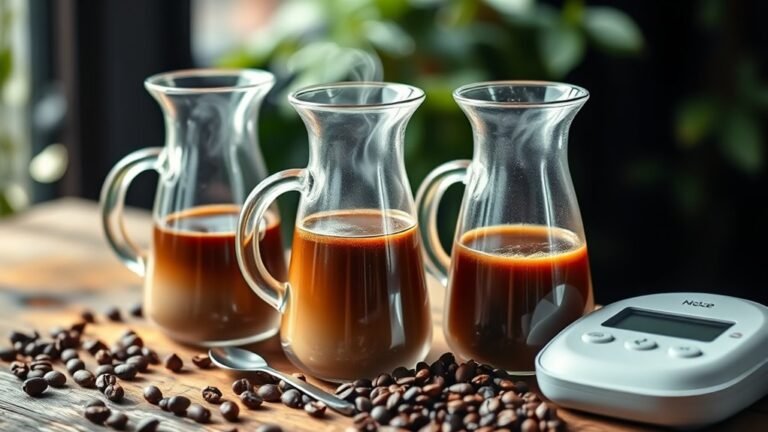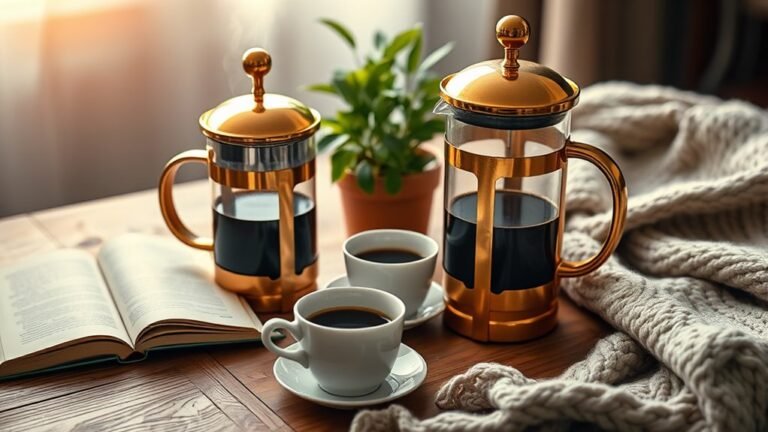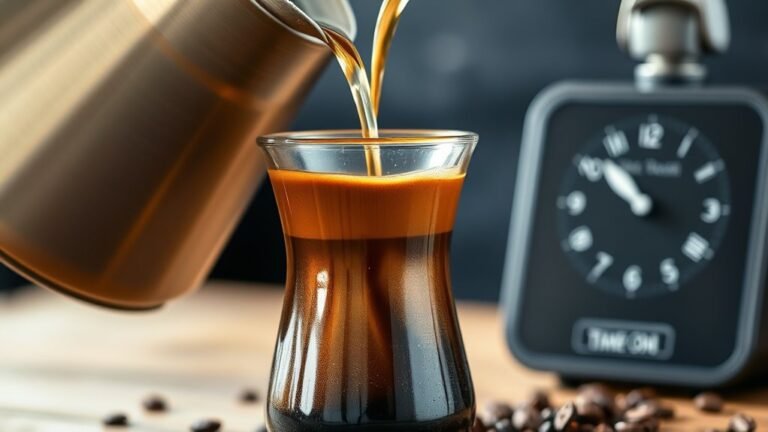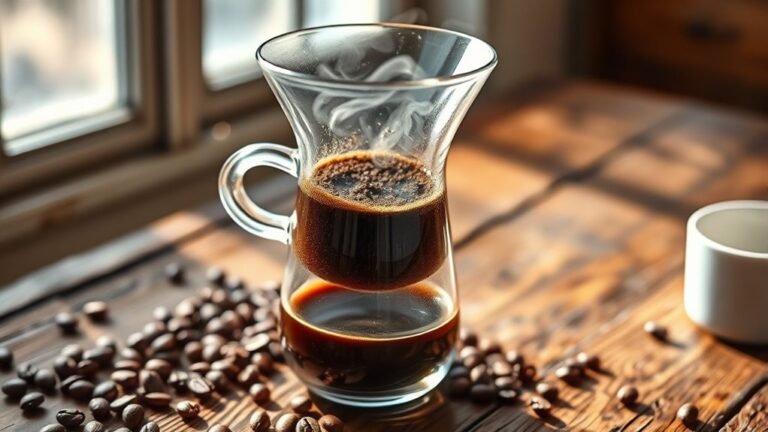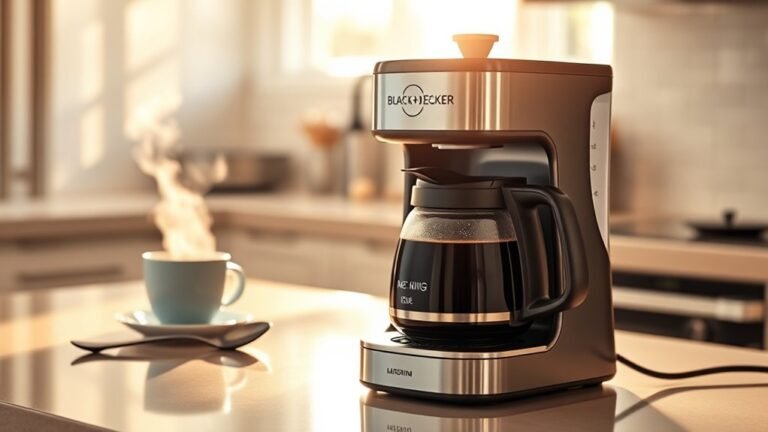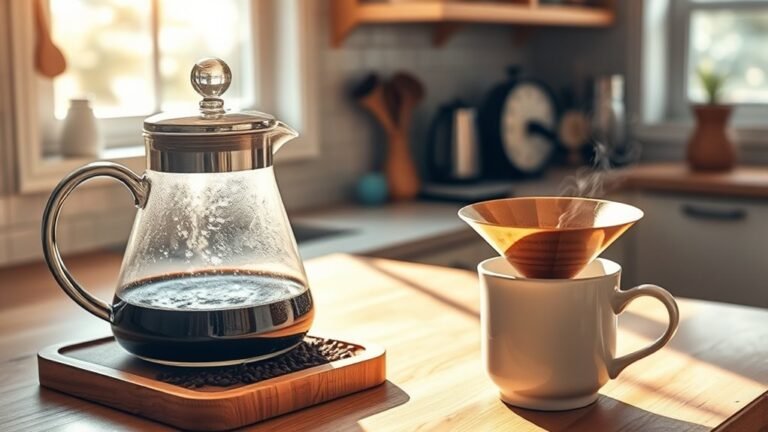Exploring Different Brewing Methods: French Press vs. Pour Over
When choosing between French Press and Pour Over, you’ll find the French Press offers a bold, full-bodied coffee by steeping coarse grounds for about four minutes, with flexibility in extraction. Pour Over delivers a cleaner, brighter flavor through precise, slow pouring over filter papers in 3 to 4 minutes. Each method demands specific equipment and exact timing to optimize extraction. If you want to refine your technique and understand their distinct pros, keep exploring these methods further.
Understanding the Basics of French Press Brewing
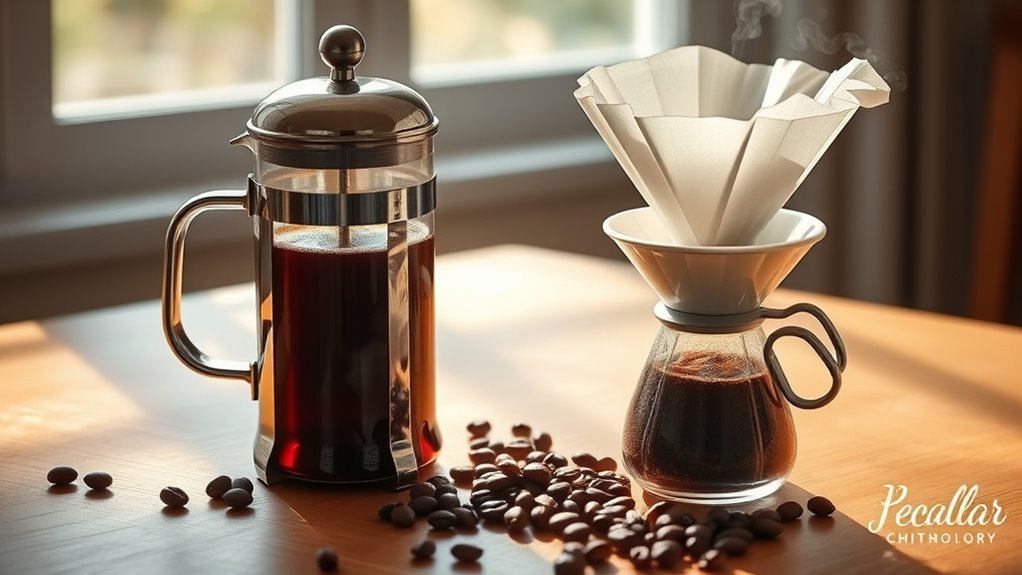
When you use a French Press, you’re relying on a full-immersion brewing method where coarsely ground coffee steep in hot water for about four minutes before being separated by a metal mesh plunger. You’ll want to control the water temperature precisely—ideally between 195°F and 205°F—to optimize extraction without scorching the grounds. The coarse grind size guarantees even saturation and prevents over-extraction, which can cause bitterness. As the coffee grounds steep, the full contact with water allows oils and soluble compounds to infuse thoroughly, delivering a rich, robust flavor profile. Pressing the plunger slowly separates grounds from liquid without filtering out essential oils, preserving body and complexity. This method grants you freedom to tailor steeping time and grind size, empowering you to craft coffee exactly to your taste.
Exploring the Pour Over Technique
While the French Press emphasizes full immersion and robust extraction, the Pour Over method takes a more controlled, layered approach to brewing. Rooted in pour over history, this technique grants you freedom to manipulate water flow, temperature, and grind size precisely. Pour over techniques involve pouring hot water in slow, circular motions, extracting nuanced flavors by controlling contact time.
| Factor | French Press | Pour Over |
|---|---|---|
| Extraction Style | Full immersion | Layered drip |
| Control Level | Moderate | High |
| Equipment | Plunger, coarse grind | Dripper, filter, fine grind |
Comparing Flavor Profiles and Aroma
When you compare the French Press to the Pour Over, you’ll notice the French Press delivers a fuller flavor intensity due to its immersion brewing and metal mesh filter, which allows more oils and fine particles to pass through. In contrast, the Pour Over uses a paper filter that extracts a cleaner, more nuanced aroma by trapping oils and sediments. Understanding these extraction differences helps you appreciate how each method highlights distinct sensory aspects of the coffee.
Flavor Intensity Differences
Although both French press and pour over methods extract coffee flavors effectively, the resulting intensity and aroma differ considerably due to variations in brewing mechanics. When you use a French press, the full immersion steeping allows oils and fine particles to remain, enhancing body and boldness, which heightens your taste perception of richness. Conversely, pour over’s controlled drip and filtration yield clarity, emphasizing delicate notes and a cleaner sensory experience.
| Aspect | French Press |
|---|---|
| Flavor Intensity | Bold, full-bodied |
| Sensory Experience | Rich, textured |
| Aspect | Pour Over |
| Flavor Intensity | Bright, nuanced |
| Sensory Experience | Crisp, refined |
These differences shape how you savor coffee’s depth and complexity.
Aroma Extraction Techniques
Understanding how aroma develops during brewing helps clarify why French press and pour over coffees present such distinct flavor profiles. In a French press, full immersion allows coffee grounds to steep, maximizing aroma release by saturating the beans with water evenly, extracting essential oils and volatile compounds that contribute to a richer, bolder scent. In contrast, the pour over’s drip method controls water flow and temperature precisely, promoting a gradual extraction that highlights nuanced aromatics and subtle flavor enhancement. You’ll notice the pour over emphasizes clarity and brightness, while the French press delivers a heavier, more robust aroma experience. Mastering these aroma extraction techniques enables you to tailor your brewing for your desired sensory freedom, balancing intensity and refinement in your cup.
Equipment and Preparation Requirements
To brew with a French Press, you’ll need the press itself, a burr grinder for coarse grounds, and a precise timer to control steeping. For pour over, essential tools include a dripper, filter papers, a gooseneck kettle for controlled pouring, and a scale for accurate measurement. Both methods require careful setup and cleanup, but the pour over demands more attention to consistent pour rates and filter disposal.
Essential Tools Needed
A well-equipped setup is vital for mastering both French Press and Pour Over brewing methods, as each demands specific tools to achieve ideal extraction. Understanding the essential tools and brewing accessories lets you control the variables impacting flavor and strength. Here’s what you’ll need:
- Precision Grinder – A burr grinder provides uniform grounds; coarse for French Press, medium-fine for Pour Over.
- Scale with Timer – Accurate measurement of coffee and water, plus timing extraction, guarantees consistency.
- Kettle with Gooseneck Spout – Allows controlled, even pouring significant for Pour Over; also useful for French Press.
- Brewing Vessel – A quality French Press or Pour Over dripper matched with filters if needed.
Investing in these precise tools grants you freedom to release each method’s full potential.
Setup and Cleanup Steps
Three key stages define the setup and cleanup process for French Press and Pour Over brewing: equipment arrangement, ingredient preparation, and thorough cleaning. Begin by organizing your French Press or Pour Over components—plunger, carafe, filters, dripper—ensuring each is accessible. Use setup tips like preheating your vessel to maintain temperature stability. Next, precisely measure and grind your coffee to match your chosen method, emphasizing consistency.
For cleanup efficiency, disassemble parts immediately after brewing. Rinse grounds promptly to prevent residue buildup, then use a soft brush or cloth for the French Press mesh and Pour Over dripper. Thorough drying prevents mold growth and preserves equipment longevity. By mastering these setup and cleanup steps, you’ll maintain ideal brewing conditions while enjoying the freedom to experiment with your coffee’s flavor profile.
Brewing Time and Ease of Use
Brewing time and ease of use play crucial roles in choosing between a French Press and a Pour Over. Your brewing efficiency and overall user experience depend on how quickly and effortlessly you can make your coffee.
- French Press typically steeps for about 4 minutes, offering a straightforward process—add grounds, pour water, wait, then press—ideal for minimal interruptions.
- Pour Over demands a slower, more controlled pour over 3 to 4 minutes, requiring precise water flow and attention to extraction timing.
- French Press setup and cleanup are simpler, enhancing your freedom to enjoy coffee without hassle.
- Pour Over’s manual control offers customization but requires practice, impacting ease of use and consistency.
Your choice hinges on whether you prioritize quick brewing efficiency or hands-on control.
Pros and Cons of Each Method
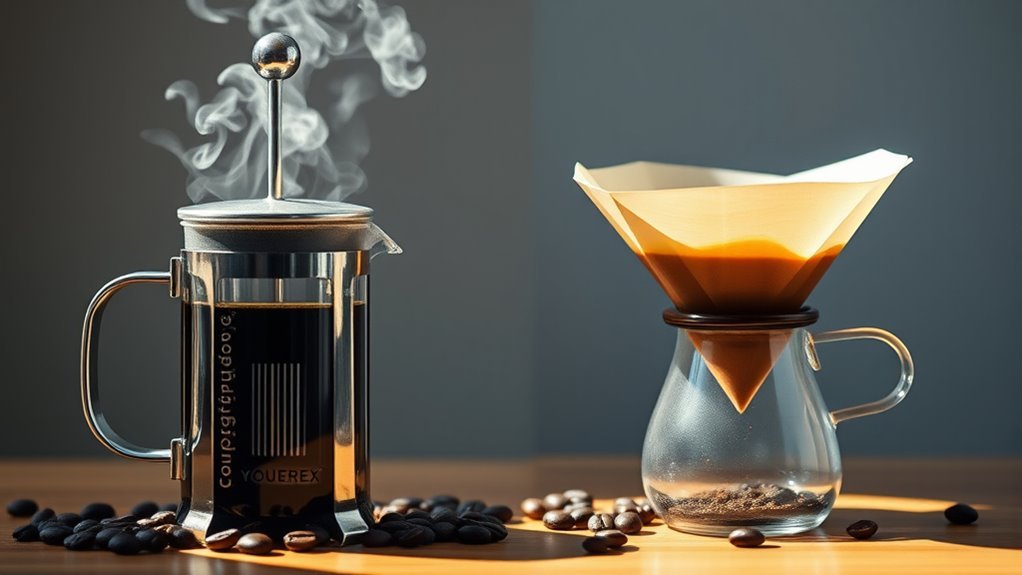
Understanding how each method handles brewing time and user interaction sets the stage for evaluating their specific advantages and disadvantages. The French press advantages lie in its full immersion technique, which extracts robust oils and flavors, offering a richer, fuller-bodied cup with minimal equipment. However, it requires precise timing and coarse grinding to avoid over-extraction or sediment. On the other hand, pour over provides exceptional control over flow rate and saturation, enhancing clarity and brightness in the cup. Yet, pour over drawbacks include increased attention and consistency demands, as uneven pouring or grind size can result in under or over-extraction. Ultimately, your choice hinges on valuing freedom to experiment with immersion’s bold profile versus the meticulous precision pour over demands for a clean, nuanced brew.
Frequently Asked Questions
Can I Use the Same Coffee Grind Size for Both Methods?
You might think one grind size fits both, but here’s the catch: grind consistency and extraction time are essential. For a French Press, you want a coarse grind to avoid over-extraction during its longer steeping. Pour Over demands a medium-fine grind for quick, even extraction. Using the same grind risks under or over-extracting, limiting your freedom to perfect each brew. Tailoring grind size reveals full flavor potential in every cup.
How Does Water Temperature Affect Each Brewing Method?
Water temperature directly impacts water extraction and brewing consistency. If you use water that’s too hot, you’ll risk over-extracting, leading to bitterness. Too cool, and under-extraction results in weak, sour flavors. For a French Press, aim for about 195-205°F to balance extraction with immersion. Pour Over benefits from slightly cooler, consistent temperatures to control flow rate and extraction uniformity. Mastering this lets you brew freely, tailoring taste precisely to your preference.
Are There Specific Coffee Beans Better Suited for French Press?
Imagine sipping coffee with a quill in hand—timeless, right? When selecting coffee beans for your French Press, focus on medium to dark roasts; their oil-rich nature enhances the flavor profile. Coarse grind is essential to avoid over-extraction and muddiness. Beans with bold, chocolatey, or nutty notes perform best, as the immersion brewing method extracts rich, full-bodied flavors, giving you the freedom to enjoy a robust, textured cup without sacrificing clarity.
What Is the Environmental Impact of Each Brewing Method?
You’ll find that both methods promote sustainability practices by minimizing single-use waste—French Press uses reusable metal filters, while Pour Over often requires paper filters, unless you opt for a reusable one. Waste reduction is key; French Press grounds can be composted directly. Pour Over’s water usage is slightly higher, but it’s precise and efficient. Choosing either supports eco-conscious habits, letting you enjoy coffee without compromising your environmental values.
Can I Brew Tea Using a French Press or Pour Over?
You can definitely brew tea using a French press or pour over. The French press lets you steep tea varieties like black or herbal with longer brewing times, around 4-6 minutes, giving full extraction. Pour over suits delicate teas, like green or white, requiring shorter brewing times of 2-3 minutes to avoid bitterness. Both methods give you control over infusion, letting you customize strength and flavor freely according to your preference.

